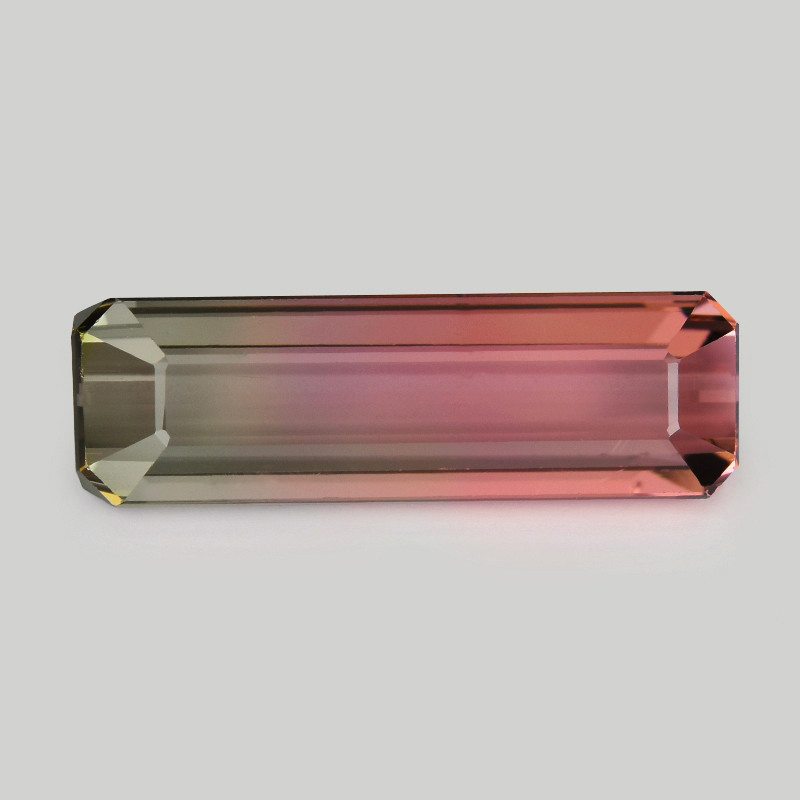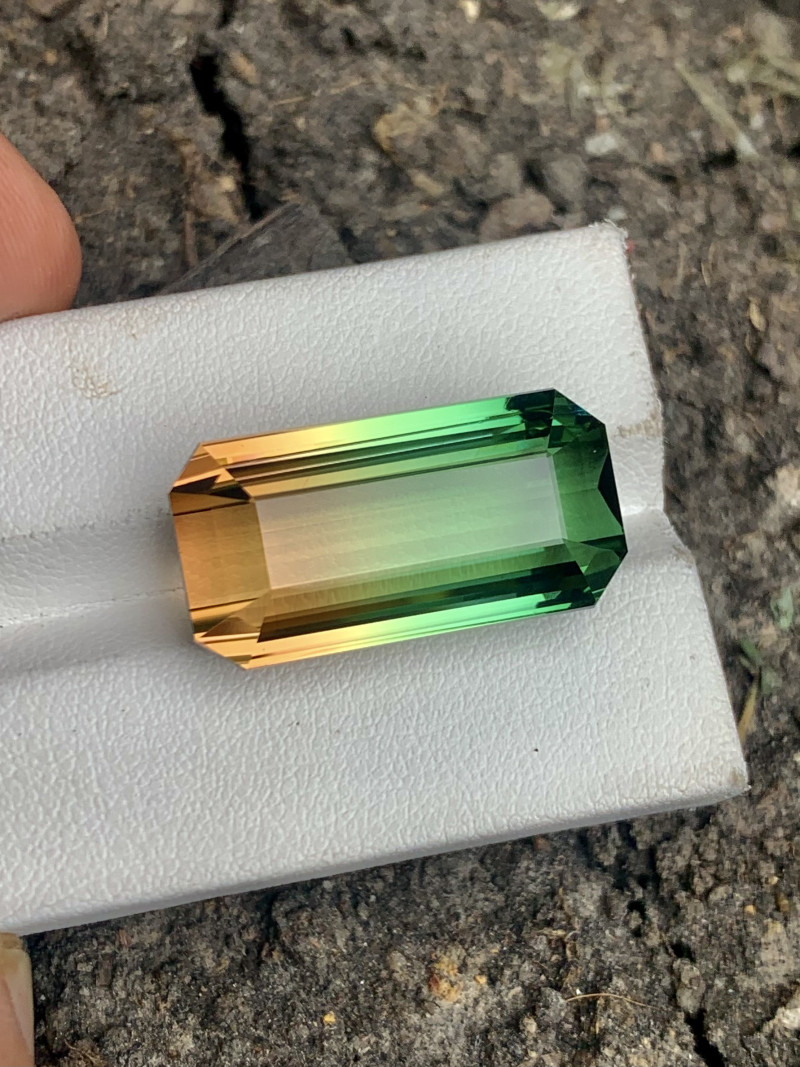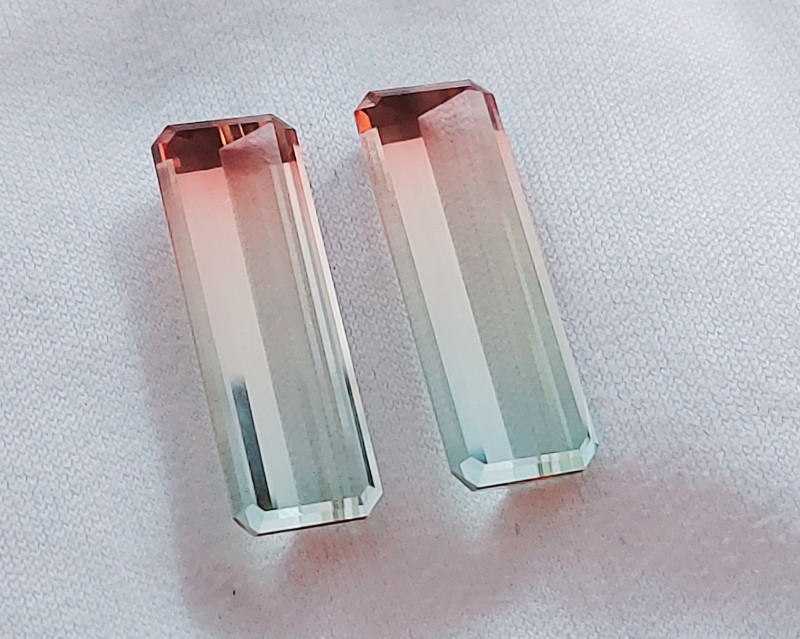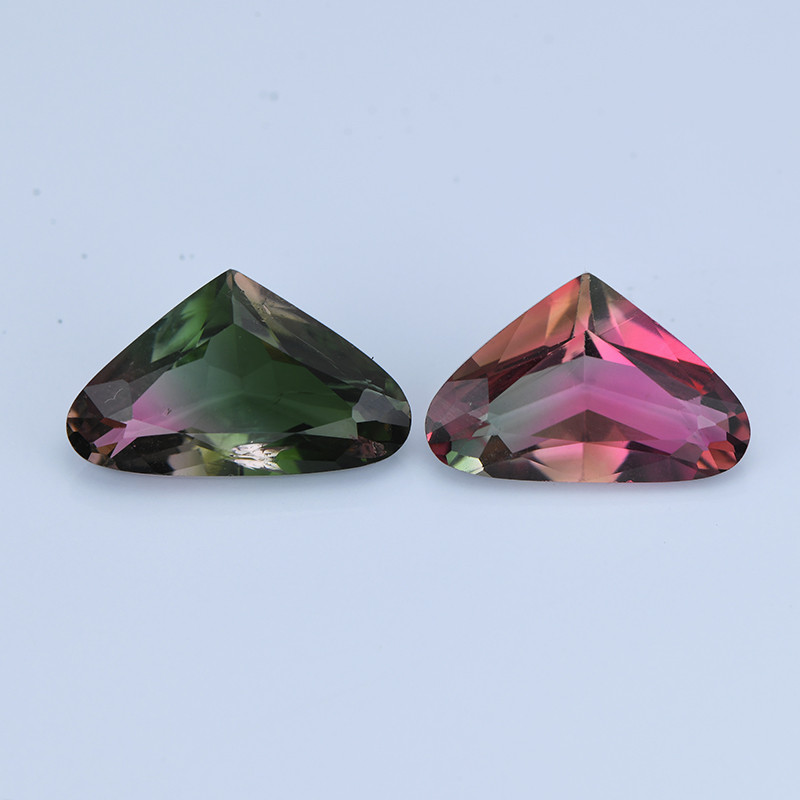
ウォーターメロントルマリン宝石:特性、意味、価値など
 明るい緑色の外層とスイカの皮を思わせる美しいピンク色の中心が特徴のウォーターメロントルマリンは、その意味と同じくらいユニークで楽しい名前の宝石です。
明るい緑色の外層とスイカの皮を思わせる美しいピンク色の中心が特徴のウォーターメロントルマリンは、その意味と同じくらいユニークで楽しい名前の宝石です。
この珍しい二色のトルマリンは、自然を美しく模倣した宝石の典型的な例です。
ウォーターメロントルマリンにはどんな効能があるのでしょうか?高価なのでしょうか?どうすれば手に入れることができるのでしょうか?このガイドでは、この魅力的な宝石の秘密をすべて解き明かします!
読み続けることで、スイカトルマリンの特性、用途、起源、価値などについて知るべきことをすべて学ぶことができます。

ウォーターメロントルマリンストーンについて
ウォーターメロン トルマリンは、夏のお気に入りのフルーツの熟したスライスを思わせる生き生きとした鮮やかな色彩でよく知られていますが、それだけではありません。
伝統的な星座石ではありませんが、ウォーターメロントルマリンは占星術において特に双子座と乙女座に良いと言われています。完璧主義の乙女座の人が過度に批判的になるのを防ぎ、落ち着きのない双子座の活発な心を落ち着かせてくれると考えられています。
ウォーターメロントルマリンは、土星と金星とも惑星的な繋がりがあります。土星は権威と構造を、金星は愛、欲望、そして人間関係を司ります。
だからこそトルマリンは結婚8周年の記念石として最適なのでしょう!
鉱物学に移り、ウォーターメロントルマリンの特徴を見てみましょう。

ウォーターメロントルマリンの仕様と特徴
この半貴石は、エルバイト変種の同心円状のカラーゾーン(不均一な色)を持つトルマリンです。内側はピンクがかった赤、外側は緑色で、その間に無色の層が挟まっていることが多いのが特徴です。
鉱物の色は、結晶の成長過程における元素の濃度や組成の変化によって生じます。ウォーターメロントルマリンの場合、カラーゾーニングによってその形成過程を視覚的に記録することもできます。
ウォーターメロントルマリンは成長して厚みを増すにつれて、マンガンやリチウムなどの鉱物にさらされます。これにより、宝石の色がピンク色の中心から淡い部分を経て緑色の縁へと変化します。
ウォーターメロントルマリンは、モース硬度7~7.5と中程度の硬度を持ちます。非常に耐久性の高い石ですが、熱や熱衝撃(急激な温度変化)によって破損したり、色褪せたりすることがあります。
ウォーターメロントルマリンの残留鉱物データの概要は次のとおりです。
成分:アルミニウム、鉄、マグネシウム、リチウム、カリウム
モース硬度:7~7.5
色:緑、ピンク、白、無色のパターンの組み合わせ
結晶構造:六方晶(三方晶)
光沢:ガラス質(ガラス状)から亜ガラス質
透明性:透明から不透明
屈折率:1.62~1.64
密度:2.90~3.40
分裂:観察されない
粘り強さ:脆い
骨折:不規則/不均一、貝殻状、貝殻下状
縞模様:白
発光:蛍光性;SW-UVでは白っぽい青またはクリーム色の白
多色性:存在し、しばしば強い;明るい緑または青に変化することがある
ギアをシフトして、ウォーターメロントルマリンの歴史を探る準備はできましたか?

スイカトルマリンの意味と歴史
「トルマリン」という言葉は、シンハラ語(スリランカ方言)で「混ざり合った色の宝石」を意味する「tōramalli 」に由来しています。ウォーターメロントルマリンを一目見れば、このカラフルなトルマリンの変種がなぜ「フルーティー」という接頭辞を得たのか、容易に想像できるでしょう。
「ウォーターメロントルマリン」という名称は、ノルウェー出身の著名な博物学者ジョージ・ロブリー・ハウ(米国メイン州)によって考案されました。1910年に地元の新聞でこの用語が使用され、その後1911年には国際的な出版物でも使用されました。
それ以来、「ウォーターメロントルマリン」という名前が定着しました。
トルマリンは古代から存在していましたが、ウォーターメロントルマリンの最初の発見時期は未だに不明です。最初の鉱物の発見記録は、1902年にメイン州ニューリーのダントン採石場で遡ります。しかし、数世紀前に発見されていた可能性もあると示唆する説も多くあります。
治癒の面から見ると、スイカトルマリンは何に良いのでしょうか?

スイカトルマリンの治癒効果
ほとんどのクリスタルは、健康の 1 つ以上の側面を助けるヒーリングストーンとして使用できます。
スイカトルマリンは、肉体、感情、精神にさまざまな形で恩恵をもたらします。
身体の治癒
スイカトルマリンがあなたの全体的な健康をどのようにサポートできるかをご紹介します。
免疫システムを強化する
代謝を高める
痛みを和らげる
緊張を和らげる
詰まりを取り除く
治癒を早める
それはあなたの医薬品キットに加えるべき強力なクリスタルです!
感情的な癒し
他のトルマリンと同様に、ウォーターメロントルマリンは心と感情を落ち着かせるのに役立ちます。トラウマを乗り越え、心の傷を癒すのに役立ちます。ネガティブな感情を自信、安らぎ、そして安心感へと変えてくれるでしょう。
次回、感情的な危機に遭遇したときは、感情的なセーフティネットを維持するために、スイカ トルマリン リングを身に着けてみてください。
チャクラヒーリング
ウォーターメロントルマリンは、ハートチャクラに作用する強力なチャクラストーンです。胸骨の真上に位置するこのエネルギーポイントは、チャクラの中心であり、人間関係、愛、自己受容、そして精神性と関連しています。
ハートチャクラが閉じていると、嫉妬、怒り、恥、あるいは自分自身や他人に対する憎しみといった感情が表れます。ウォーターメロントルマリンはこのチャクラのバランスを整え、喜び、自分自身や他人への思いやり、そしてより深い精神的な気づきを促します。
では、ウォーターメロントルマリンの価値はどうやってわかるのでしょうか?それはグレードの問題です!

ウォーターメロントルマリンの宝石特性
専門家は、宝石の品質を様々な要素に基づいて評価します。ウォーターメロントルマリンの1カラットあたりの価格は、通常、色、カット、透明度、カラット重量、処理に基づいて決定されます。
色
トルマリンには虹のあらゆる色合いがありますが、トルマリンの中で最も希少な色は何でしょうか?それは特定の青色、特にパライバトルマリンのネオンブルーです。
最も人気があり、切望されるウォーターメロントルマリンは、緑色の外層が徐々に鮮やかなピンク色へと変化していく特徴を持っています。これらは「真の」ウォーターメロントルマリンと呼ばれ、同種の他の石よりも高価です。
興味深いことに、ウォーターメロントルマリンは他の色の組み合わせで出現することもあります。例えば、「逆ウォーターメロン」模様は、外側のリングがピンクで中心がグリーンです。稀に青色の色合いを持つ宝石も存在します。
ほとんどのカラートルマリンは多色性を示し、角度によって色が変化します。この現象は、宝石によって顕著に現れる場合とそうでない場合があります。
カット
カットされていないウォーターメロントルマリン(原石)は一般的です。標本の輝きや鮮やかさは様々ですが、この鉱物を入手する最も手頃な方法と言えるでしょう。
ウォーターメロン トルマリンは、その有名な色のブランドを最もよく見せるために、薄く磨かれたスライスにカットされることがよくあります。
プリンセス、クッション、ペア、その他の人気の宝石の形など、 ファセットカットされたウォーターメロントルマリンも見つかります。
多くのウォーターメロントルマリンには、 シャトヤン効果(または「キャッツアイ」効果)が見られます。そのため、これらの標本は光学現象を際立たせるためにカボションカットされ、高値で取引されます。
耐久性に優れているため、目を引くスイカ型トルマリンの彫刻も市場に溢れています。

明瞭さ
カラーストーンは3つのクラリティグレードのいずれかに分類されます。ウォーターメロントルマリンはタイプIIIに分類されます。
ウォーターメロントルマリンのほとんどには、目に見えるインクルージョン(アパタイト、マイカ、ジルコンなど)があり、宝石の欠陥と見間違えられやすいことがあります。これは、合成石と見分ける際の真贋判定基準にもなっています。
カラット重量
トルマリンの結晶は大小様々ですが、ウォーターメロントルマリンは通常、小さめのサイズで発見され、3カラットを超えることは稀です。4カラットを超える宝石は希少で、そのため高価です。
治療
トルマリンの中には、色を鮮やかにするために処理されているものがあります。最も一般的な処理は、加熱と放射線照射です。
熱処理による変化は安定しており、目に見えることはほとんどないため、価値に影響を与えることはほとんどありません。しかし、液体インクルージョンを多く含む宝石は、加熱に耐えられません。
宝石の透明度を高めるために、レーザードリリングやフラクチャーフィリングが行われることがあります。これらの処理は価値を下げる可能性があります。
しかし、偽物のスイカトルマリンはどうでしょうか?
合成繊維
トルマリン自体は比較的豊富ですが、本物の高品質なウォーターメロントルマリンは希少で貴重です。ウォーターメロントルマリンの模造品は低価格で販売できるため、より幅広い市場にアピールできます。
類似品のウォーターメロン トルマリンは通常、ガラス、プラスチック、またはより安価な宝石で作られています。
では、スイカトルマリンが本物か偽物かはどうやって見分けられるのでしょうか?
本物のウォーターメロントルマリンは、色の変化の間にグラデーションのようなグラデーションが見られますが、模造品は通常、色相の境界線がより鮮明です。また、本物のウォーターメロントルマリンにも内包物が含まれていることがよくあります。そのため、内包物がなく、透明度が完璧すぎる石は、偽物である可能性が高いです。
価格も考慮する必要があります。天然ウォーターメロントルマリンは、トルマリンの中でも最も価値の高い種類の一つです。そのため、宝石の価格が低めに設定されている場合、偽物である可能性が高いです。
ところで、天然のスイカトルマリンはどのようにして形成されるのでしょうか?

スイカトルマリンの形成と産地
すべてのトルマリンはペグマタイト岩石中に産出します。ペグマタイトとは、地下深くにある、鉱物を豊富に含むマグマで満たされた空洞のことです。マグマが冷えると、これらの鉱物が結晶化し、トルマリンの結晶が形成されます。
しかし、スイカトルマリンはどうでしょうか?
ウォーターメロントルマリンのカラーゾーニングは、生成中に微量元素の量または種類が変化することによって発生します。
地理的に、ウォーターメロントルマリンはどこで採掘されるのでしょうか?
採掘場所
北米のメイン州(ウォーターメロントルマリンが初めて発見された場所)は、その美しい標本で有名です。しかし、ブラジルもまた、驚くほど透明で鮮やかな色彩を特徴とする宝石品質のウォーターメロントルマリンで有名です。
その他の注目すべき地域は次のとおりです。
アルゼンチン
アフガニスタン
マダガスカル
メキシコ
ナミビア
ナイジェリア
アメリカ合衆国(アリゾナ州、カリフォルニア州、コロラド州、コネチカット州、マサチューセッツ州)
ウォーターメロントルマリンのご購入準備はできましたか?ご予算の準備をお手伝いいたします。

ウォーターメロントルマリンの価格と価値
宝石を買い始めると、「なぜウォーターメロントルマリンはこんなに高価なのか?」と疑問に思うかもしれません。
最近ウォーターメロントルマリンの価値が急騰している理由は、この鉱物の鉱山がここ数年で枯渇し、ウォーターメロントルマリンの入手が困難になり、結果的に価格が上昇したためだ。
それでも、ほぼあらゆる価格帯に対応できるオプションがあります。
ウォーターメロントルマリンの原石の平均価格は1カラットあたり3ドルから8ドルです。しかし、品質の低いものは1カラットあたり1.70ドルという低価格で見つかることもあります。高品質のものになると、1カラットあたり17ドルという高値で取引されることもあります。
価格の手頃さという点では、 ファセットカットのウォーターメロントルマリンが最も高値で取引される傾向があります。ファセットカットの宝石は通常、1カラットあたり20ドルから55ドルの範囲です。低価格のファセットカットの標本は1カラットあたり約10ドルで見つかりますが、高級な宝石になると1カラットあたり約80ドルのものもあります。
ウォーターメロントルマリンのカボションはやや安価で、1カラットあたり約15ドルから40ドル程度です。中には1カラットあたり360ドルという高値のものもあれば、5ドルという安値のものも存在します。
ウォーターメロントルマリンジュエリーの価格はデザインによって異なります。卸売価格は通常以下のとおりです。
指輪: 50 ドルから 3,500 ドルの間ですが、最低 10 ドルから最高 15,000 ドルまでの価格になることもあります。
ブレスレット: 16 ドルから 800 ドルの間ですが、最低 5 ドルから最高 3,700 ドルまでの価格になることもあります。
ペンダント: 15 ドルから 5,900 ドルの間ですが、最低 4 ドルから最高 15,700 ドルまでの価格になることもあります。
スイカ型トルマリンの彫刻は、ユニークな装飾品やコレクターアイテムとして最適です。品質、複雑さ、サイズによって、価格は12ドルから4,600ドルの範囲です。
最後に、 宝石のお手入れに関するヒントをいくつか紹介して、ガイドを締めくくりましょう。
ウォーターメロントルマリンのお手入れとメンテナンス
ウォーターメロン トルマリンは日常的に着用できる実用的な石ですが、保護セッティングが施されたジュエリーは、宝石の寿命をできるだけ長く延ばすのに役立ちます。
ウォーターメロントルマリンのお手入れは比較的簡単です。柔らかい毛のブラシ、ぬるま湯、そして低刺激の石鹸があれば大丈夫です。しっかりと乾燥させてから、冷暗所に保管してください。
色あせや損傷を防ぐため、スイカトルマリンを以下のものから遠ざけてください。
機械式クリーナー(超音波、スチームなど)
より硬い宝石と素材
極度の暑さや直射日光
過剰な湿気や水
急激な気温の変化
刺激の強い化学物質や香料

ウォーターメロントルマリンで涼しく過ごしましょう!
心はもう太陽のよう?ウォーターメロントルマリンの明るくハッピーな色彩は、どんな服装やクリスタルコレクションにも夏の雰囲気を添えてくれます。ピンクとグリーンの可愛らしいアクセントが、みんなを笑顔にしてくれます。
一年中続く熱帯の至福?ぜひ参加してください。
Gemstone Encyclopedia検索
最新記事
鮮やかな赤い模様と文化的意義で珍重される希少な宝石、チキンブラッドストーンの歴史、特性、価値、お手入れのヒントをご紹介します。
8th Dec 2025
ゲイラス石は、乾燥しやすいため白濁しやすい希少鉱物で、主に工業用途で使用されています。この完全ガイドで、ゲイラス石の歴史、特性、用途、そして特徴をご覧ください。
7th Dec 2025
チオライトは、氷晶石に似た、無色から白色の希少鉱物です。宝石としては非常に希少で、限られた産地からしか産出されません。チオライトの用途、歴史、価格、特徴についてはこちらをご覧ください。
5th Dec 2025
記事のカテゴリ
How To's is where you will find helpful articles from gem Rock Auctions on how to cut gemstones, select gemstones and buy gemstones.
9記事数



